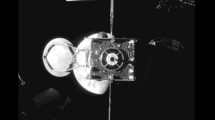Hera will conduct a post-impact survey of the Dimorphos asteroid that was hit off course in 2022.
 Europe’s Hera asteroid probe took off from Florida on a SpaceX Falcon 9 rocket on October 7, 2024, beginning a two-year voyage to revisit the Dimorphos asteroid that was hit off course by NASA’s DART spacecraft in 2022. Built by Germany’s OHB SE, Hera will conduct a post-impact survey of Dimorphos in order to help expand the U.S. space agency’s experimental collision into a repeatable strategy for planetary defence, according to European Space Agency. The return to Dimorphos after a two years after the historic collision is the latest step in efforts to see whether an incoming small asteroid could, if required, be deflected from Earth to prevent potentially widespread damage.
Europe’s Hera asteroid probe took off from Florida on a SpaceX Falcon 9 rocket on October 7, 2024, beginning a two-year voyage to revisit the Dimorphos asteroid that was hit off course by NASA’s DART spacecraft in 2022. Built by Germany’s OHB SE, Hera will conduct a post-impact survey of Dimorphos in order to help expand the U.S. space agency’s experimental collision into a repeatable strategy for planetary defence, according to European Space Agency. The return to Dimorphos after a two years after the historic collision is the latest step in efforts to see whether an incoming small asteroid could, if required, be deflected from Earth to prevent potentially widespread damage.Dimorphos is a moonlet of Didymos, which is defined as a near-Earth asteroid. The DART (Double Asteroid Redirection Test) spacecraft was a proof-of-concept mission designed to use a spacecraft to nudge a celestial object that might otherwise strike Earth. Dimorphos and Didymos do not pose an actual threat to Earth. The spacecraft collided on September 26, 2022, at about 14,000 miles per hour (22,530 kph) into Dimorphos, roughly 6.8 million miles (11 million km) from Earth.
In March, scientists said that the collision changed not only the small asteroid’s path but its shape as well.
There are more than half a million asteroids in the solar system, of which over 25,000 are classified as near-Earth objects. Of these, more than 1,000 are in ESA’s risk list, meaning that they merit close follow-up observations, according to the agency.














Add Comment